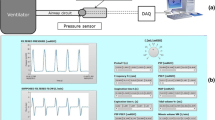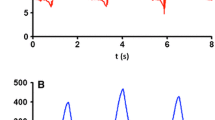Abstract
Objective. Ventilatory measurements in ventilated newborns are increasingly used to monitor and to optimize mechanical ventilation. The aim of this study was to compare the accuracy of volume measurements by different instruments using standardized laboratory conditions. Methods. The accuracy of displayed volume values of different commercial devices (Bicore CP-100, Ventrak 1500, Ventrak 1550, Babylog 8000, PEDS IV and SensorMedics 2600) was investigated using adjustable calibration syringes (volume range 2–60 ml, breathing rates 30/min–60/min) and humidified (>95%), heated (35 °C) breathing gas with adjustable FIO2 (0.21–1.0). The pneumotach and also the tubes were placed within an incubator (37 °C). Results. The relative volume error of all devices was in conformity with clinically allowed tolerances (Bicore CP-100 6.4 ± 0.5% (mean ± SD), Ventrak 1500 3.6 ± 4.2%, Ventrak 1550 6.5 ± 2.7%, Babylog 8000 −5.5 ± 1.5%, PEDS IV −4.0 ± 1.4%, SensorMedics 2600 3.5 ± 1.75%) for the measuring range studied (10 ml < V < 60 ml, rate 30–60/min, FIO2 = 0.21). Unacceptable errors were obtained for volumes lower than 10 ml with Bicore CP-100 (−28.5 ± 26%) and PEDS IV (−10.3 ± 3.4%). Changes in FIO2 had an important influence on volume measurements and only the SensorMedics 2600 and the PEDS IV corrected properly for FIO2 changes. Conclusion. Most of the currently available neonatal spirometry devices allow sufficiently accurate volume measurements in the range of 10–60 ml and at frequencies between 30–60/min provided that an increased FIO2 is taken into account.
Similar content being viewed by others
REFERENCES
Fisher JB, Mammel MC, Coleman JM, Bing DR, Boros SJ. Identifying lung overdistention during mechanical ventilation by using volume-pressure loops. Pediatr Pulmonol 1988; 5: 10-14.
Simbruner G. Lung mechanics and mechanical ventilation. Crit Care Med 1993; 21: 369-370.
Carlo WA, Martin RJ. Principles of neonatal assisted ventilation. Pediatr Clin North Am 1986; 33: 221-237.
Greenough A. Patient-triggered ventilation. Pediatr Pulmonol Suppl 1995; 11: 98-99.
Nikischin W, Gerhardt T, Everett R, Gonzalez A, Hummler H, Bancalari E. Patient-triggered ventilation: Acomparison of tidal volume and chestwall and abdominal motion as trigger signals. Pediatr Pulmonol 1996; 22(1): 28-34.
John J, Bjorklund L, Svenningsen N, Jonson B. Airway and body surface sensors for triggering in neonatal ventilation. Acta Paediatr 1994; 83(9): 903-909.
Stocks J, Sly P, Tepper R, Morgan W. Infant respiratory lung function testing. New York: John Wiley & Sons 1996.
Hjalmarson O. Lung function testing-useless in ventilated newborns? Eur J Pediatr 1994; 153: 340-361.
Vallinis P, Davis GM, Coates AL. A very low dead space pneumotachograph for ventilatory measurements in newborns. J Appl Physiol 1990; 69: 1542-1545.
Ruttimann UE, Galioto FM Jr, Franke JR, Rivera O. Measurement of tracheal airflow in newborns by a differential flow system. Crit Care Med 1981; 9: 801-804.
Edberg KE, Sandberg K, Silberberg A, Sjoqvist BA, Ekstrom Jodal B, Hjalmarson O, Kugelman A, Keens TG, Delemos R, Durand M. A plethysmographic method for assessment of lung function in mechanically ventilated very low birth weight infants-comparison of dynamic and passive measurements of respiratory mechanics in ventilated newborn infants. Pediatr Res 1991; 30: 501-504.
Buess C, Pietsch P, Guggenbühl W, Koller EA. A pulsed diagonal beam ultrasonic airflow meter. J Appl Physiol 1986; 61: 1195-1199.
Jackson E, Coates A, Gappa M, Stocks J. In vitro assessment of infant pulmonary function equipment. Pediatr Pulmonol 1995; 19: 205-213.
Kreit JW, Sciurba FC. The accuracy of pneumotachograph measurements during mechanical ventilation. Am J Crit CareMed 1996; 154: 913-917.
LeSouef PN, England SJ, Bryan AC. Total resistance of the respiratory system in preterm infants with and without an endotracheal tube. J Pediatr 1984; 104: 108-111.
Sly PD, Brown KA, Bates JH, Spier S, Milic Emili J. Noninvasive determination of respiratory mechanics during mechanical ventilation of neonates: A review of current and future techniques. Pediatr Pulmonol 1988; 4: 39-47.
Kuo CY, Gerhardt T, Bolivar J, Claure N, and Bancalari E. Effect of leak around the endotracheal tube on measurements of pulmonary compliance and resistance during mechanical ventilation: A lung model study. Pediatr Pulmonol 1996; 22: 35-43.
Wilks PA, English MJ. Accurate segmentation of respiration waveforms from infants enabling identification and classification of irregular breathing patterns. Med Eng Phys 1994; 16(1): 19-23.
Turner M, Davies V, De Ravel T, Rothberg A, MacLeod I. Bandwidths of respiratory gas flow and pressure wave-forms in mechanically ventilated infants. Physiol Meas 1993; 14 (4): 419-431.
Taussig L, Harris TR, Lebowitz MD. Lung function in infants and young children. Am Rev Respir Dis 1977; 116: 233-239.
Hummler H, Gerhardt T, Gonzalez A, Bolivar J, Claure N, Everett R, Banclalary E. Patient-triggered ventilation in neonates: Comparison of a flow-and an impedance-triggered system. Am J Respir Crit Care Med 1996; 154: 1049-1054.
Hird MF, Greenough A. Causes of failure of neonatal patient triggered ventilation. Early Hum Dev 1990; 23: 101-108.
Turner MJ, MacLeod IM, Rothberg AD. Calibration of Fleisch and screen pneumotachographs for use with various oxygen concentrations. Med Biol Eng Comput 1990; 28: 200-204.
Foitzik B, Schmalisch G, Wauer RR. Effect of physical properties of respiratory gas on pneumotachographic measurement of ventilation in newborn infants. Biomed Tech Berlin 1994; 39: 85-92.
Author information
Authors and Affiliations
Corresponding author
Rights and permissions
About this article
Cite this article
Roske, K., Foitzik, B., Wauer, R.R. et al. Accuracy of Volume Measurements in Mechanically Ventilated Newborns: A Comparative Study of Commercial Devices. J Clin Monit Comput 14, 413–420 (1998). https://doi.org/10.1023/A:1009993916980
Issue Date:
DOI: https://doi.org/10.1023/A:1009993916980




